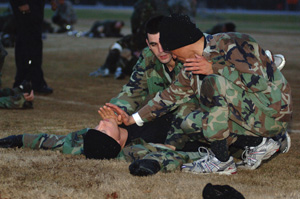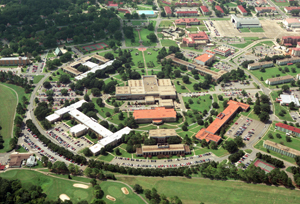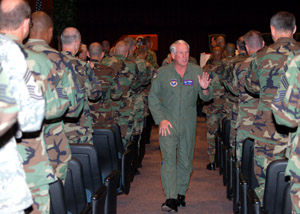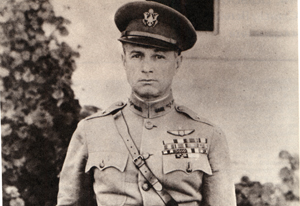It takes much longer to train upper officers in an air force than it does in a ground army or navy.” Such were the sober words of Maj. Gen. William Mitchell, the famous airman, in his seminal 1925 book, Winged Defense.
Were he alive today, Mitchell would see that the job has, if anything, only gotten harder.
Today’s “upper officers” are now required to learn foreign languages, cultures, joint warfighting, strategy, leadership—and squeeze in the art of airpower, too. Indeed, senior USAF leaders are formulating major changes to the curriculum and expanding the resources for education at all levels. The effort ranges from Junior Reserve Officer Training Corps programs in high schools to doctoral work at the Air Force Institute of Technology.
At the core of the new effort is Air University at Maxwell AFB, Ala. The historic campus in Montgomery, Ala., is abuzz with change. Much is internal, as the institution adapts curriculum and structures to meet needs of an expeditionary force. There is also an outward focus: The Air Force seeks to make AU the world’s center of air, space, and cyberspace thought.
Said AU’s commander, Lt. Gen. Stephen R. Lorenz: “You have to stir the passions to get people to believe. We need to have a thick skin to push [understanding of] air, space, and cyberspace around the world.”
The first wave of change crested in June 2004, when AU gained accreditation of the Southern Association of Colleges and Schools. Congress already had granted AU the right to confer master’s degrees, and both the Community College of the Air Force and the School of Advanced Air and Space Studies had achieved full accreditation. However, AU’s success in the formal and rigorous accreditation process made AU a true academic institution.
 |
Capt. Jay Phomavong (r) instructs an unidentified officer trainee as part of the new Air Force Combative Program at Maxwell AFB, Ala. (USAF photo by MSgt. Scott Moorman) |
An Air, Ground, Space Fight
Then, Air Force senior leaders set in motion a wholesale re-examination of what it takes to educate airmen. The rethink was overdue. “The airman of today is vastly different from five or 10 years ago,” noted Gen. William R. Looney III, commander of Air Education and Training Command, which oversees AU.
Looney explained that, in former times, “most of the fighting was done by the folks who got into airplanes, because we fought from sanctuaries,” but that, now, airmen fight equally in the air, on the ground, or in cyberspace. Education—both the type and the timing—needs to reflect the needs of a force committed to diverse, global operations.
Example: Instead of waiting for years to attend Squadron Officer School, the youngest officers meet and work with officers outside their specialties much earlier than used to be the case. This change reflects the fact that deployed airmen must work with everyone from security forces and engineers to communicators and aircrews. The education process aims to give them a leg up by adding that cross-tribal exposure early in their careers.
For Lorenz, another crucial step was tightening the organizational structure of AU to implement course and curriculum changes quickly and consistently. The original structure mimicked universities, with separate colleges for distinct educational missions. The World War II generals who took over AU looked at the missions and saw Harvard or Oxford.
“I saw squadron and wing command,” said Lorenz,who has been nominated for a fourth star and to succeed Looney.
Thus, AU is now organized like a flying wing. The Air War College, School of Advanced Air and Space Studies, Air Command and Staff College, Squadron Officer School, and Air and Space Basic Course center come under an umbrella organization which leaders hope will be called the Carl A. Spaatz Center for Officer Education.
Today, officer professional education falls under a single commander. The point was to link faculty and administration in a way that made the curriculum more flexible and adaptable. Each school still has a distinct faculty and focus, but the process of adding new topics and evaluating changes is much more tightly linked to keep pace with real-world demands on airmen.
“Now everybody is a warrior-airman,” said Looney. “We focus more on teaching warrior skills. It’s more of a combat-focused curriculum.”
The flying wing structure comprises all facets of education, from accessions through senior service school. Perhaps the single most dramatic change was the insertion of language and culture into the curriculum. In the garrison force of the 1970s and 1980s, most officers had little need for language and culture skills.
The formation of the Expeditionary Aerospace Force in the 1990s and then the onset of the Global War on Terrorism after September 2001 changed all that. In 2006, USAF’s Chief of Staff, Gen. T. Michael Moseley, mandated Air Command and Staff College students receive language instruction in French, Spanish, Arabic, or Mandarin Chinese.
 |
An aerial shot of the sprawling Air University campus. AU provides education for airmen from precommissioning to degree granting and professional continuing education for officers, enlisted, and civilian USAF personnel. (Air University photo) |
Cultural Literacy
Adding language instruction was a serious undertaking, and there were complaints from students ranging from the quality of the instruction to the relative importance of language and other core topics. (A two-year pilot program testing different methods of instruction will undergo an assessment this summer.)
Cultural training is set to spread throughout the AU curriculum. The top academic leadership sees the issue as bigger than merely learning how to read street signs or ask directions in the chosen language. Take, for example, the case of Brian R. Selmeski. A new addition to the faculty, Selmeski holds a Ph.D. in anthropology and served on active duty with the Army. His task at AU is to help build the curriculum to improve cross-cultural competence for airmen. That includes not just language training but also exposure to cultural anthropology concepts. The goal: Help airmen learn to ask the right questions, size up indigenous social factors, and understand the local power realities.
A better grasp of tribe politics may also assist in yet another big endeavor: educating airmen for the war of ideas. AU is unabashedly pushing to become an intellectual powerhouse on airpower, space, and cyberspace matters. AU leaders believe the ongoing worldwide clash has underscored the need to compete in the world of ideas. That includes sharpening the abilities of airmen to speak for airpower.
“We should be the resident experts when it comes to air, space, and cyber,” said Looney.
Lorenz would like to see AU increase its “intellectual throw weight” and cement an international reputation as the main source for leading airpower ideas.
A major part of that effort is the reinvigoration of AU faculty research activities. In a recent journal article, Lorenz pointed out that AU instructors often had greater incentives to research topics unrelated to the Air Force than to examine questions pertaining to air, space, and cyberspace. He noted that one study found that for every book on airpower, four or five were written about landpower.
Lorenz also pointed out that AU faculty tended to receive greater rewards for research aimed at academic peers than they did for work delivered to policy-maker audiences.
 |
Gen. William Looney III, then-commander of Air Education and Training Command, is applauded by airmen as he leaves the Air Force Senior NCO Academy auditorium. (USAF photo by MSgt. Lee Roberts) |
Not Just Lessons Learned
Today, the AU leadership seeks to expand the production of airpower studies—ranging from “lessons learned” to sustained and scholarly research products. In aid of that effort, elements of legacy research organizations at AU have been reconstituted as the brand-new Air Force Research Institute. Retired Gen. John A. Shaud, a former executive director of the Air Force Association, will serve as the first director of the new institute.
The institute houses AU’s only full-time research staff. It is also home to AU’s Air and Space Power Journal and AU Press.
Research will be performed by regular staff, faculty on sabbatical, and teaching faculty. Outside scholars will have the opportunity to work under contract to produce significant works on air, space, and cyberspace topics.
According to Col. Mike Davis, AFRI’s deputy director, the institute’s charter calls for providing studies to the Air Staff and USAF’s major commands. The group has recently been assisting the Chief of Staff with evaluating Air Force strategy.
The research institute staff will be associated with doctrine analysts working within the newly named Curtis E. LeMay Center for Doctrine Development and Education. The development of doctrine has been centralized at Maxwell since 1997. USAF’s first dedicated doctrine center put doctrine development in the fast lane and improved the presence of Air Force doctrine in joint doctrine development. The center’s commander, Maj. Gen. Allen G. Peck, serves also as vice commander of AU.
Doctrine developers keep core publications up-to-date. They’ve also taken the lead in developing the newest Air Force doctrine, such as that for cyberspace operations. The process of distilling doctrine from practice, experience, and theory taps many of AU’s resources.
For most officers, when and how to get a master’s degree is a big challenge. Ten years ago, it was received wisdom that captains needed a master’s degree to compete for promotion to major.
Back then, AU didn’t grant academic degrees, so most completed the degree by working part-time, usually with a civilian university whose program was adapted to the needs of the military officer. Over the last several years, policy has fluctuated. In some years, board procedures “reveal” whether the competing captains have the degree—and in other years, they don’t.
Today’s airmen want education options and Lorenz specifically set out to give airmen a wider menu of choices. With accreditation in hand, AU now offers master’s degrees for resident students and nonresidents who complete their work via distance learning. The distance learning program is so popular that the biggest challenges have been recruiting enough faculty for the Web-based courses, making sure base servers don’t crash out during instruction, and revising curriculum fast enough to meet the growing demands.
The goal is to give all airmen the opportunity to earn a master’s degree by the 12-year point of their careers.
Educating airmen does not stop with the officer schools of the Spaatz Center: USAF’s airmen constitute the best-educated enlisted force in the world.
Last year, 17,456 enlisted airmen earned associate degrees from the Community College of the Air Force. That is three times the number in the other services, combined. New enlisted airmen are automatically enrolled when they join the Air Force. Courses cover many topics, with aircraft maintenance, criminal justice, and health sciences among the most popular.
Education is a big draw for enlisted airmen. “We’re seeing education numbers up dramatically even as the resource pool is down,” said Col. Thomas D. Klincar, commander of the College for Enlisted Professional Military Education.
Just as important is the transition from two-year to four-year degree. AU seeks to make the process as smooth as possible. About 2,200 students are currently enrolled in a program that leads to a four-year degree. Twenty-four civilian colleges have partnered with AU to accept 100 percent of credit hours students bring from the Community College of the Air Force.
 |
William Mitchell quickly recognized that it takes much longer to effectively train airmen compared to ground or Navy officers. |
Not Willing To Move Backward
A Web-based enrollment system transfers credits and registers students. Lorenz described the process as “12 clicks and you’re a junior.”
With the Air Force facing constant budget and manpower cuts, can the emphasis on educating airmen be sustained
For Looney, the answer is yes. “Even in challenging times, the corporate Air Force has made the commitment to fund education initiatives. If we don’t do it, we lose the opportunity forever.”
Lorenz and the AU staff pushed back hard against proposed manpower cuts that the Pentagon sought to impose on AU. That cut action would have stripped AU of hundreds of manpower positions, which would have crippled the institution. The output of students is directly related to faculty size. Air War College, for example, must sustain a ratio of one faculty member for every 3.5 students if it is to maintain high quality. What’s more, the faculty-to-student ratio is also mandated under the terms of joint professional military education. Hence, even small cuts in faculty size can have a huge negative effect.
AU went back to Moseley with a different proposal. USAF was “not willing to accept a less educated force,” said Looney.
This was a key decision, because education continues to increase in importance for both Air Force and national defense needs. The mission constantly evolves, but it has a long tradition. It is clear that the mission has entered a new and far more active phase.
|
The Long Saga of Airpower Education Education of American airmen has been a fixture around Montgomery, Ala., for quite some time, going all the way back to when the Wright brothers, in 1910, briefly leased Maxwell Field as a flying school to teach takeoffs, turns, and landings. When the Air Corps Tactical School moved from Langley Field, Va., to Maxwell Field in 1931, educating airmen was about developing and proving the competencies of airpower. The Air Corps Tactical School functioned much as any other Army school of its day. It developed advanced tactics, and schooled and cultivated officers. Instruction ceased in 1940 and Maxwell Field became a training center for thousands of cadet airmen. Yet there was something unique, too. The core work of ACTS laid the foundations for operational and strategic application of airpower in World War II and for the independence of the Air Force. According to historian Walter J. Boyne, 261 of the 320 Army Air Forces general officers who were on duty at the end of World War II were ACTS graduates. The new AU stood up in March 1946. Students first enrolled in Air Command and Staff School and Air War College that autumn. Educating airmen—or at least a select group of them—was widely recognized as an essential function for an independent Air Force. The model of the day was copied from august civilian institutions. AU formed a board of visitors composed of top civilian academic officials to ensure that the curriculum would maintain academic excellence. AU in those days gave airmen a way to develop into more capable officers and it also added a gloss for many whose educational opportunities had been limited. The model suited the educational needs of the early Cold War period. Few officers had completed four-year degrees. Enlisted education was barely on the horizon. Leadership, the operational art of warfare, strategy, and skills for staff work were at the heart of the curriculum. Most of all, AU sought to fill gaps in professional education for officers. Winning a student slot was prestigious, but the school experience itself gained a reputation as less than challenging. Many students took advantage of the time for rigorous research, and making acquaintances with international officers was a big feature of the AU experience, but gentlemen’s education and the midcentury university model still dominated. Several important changes took place in the 1990s. After Operation Desert Storm, joint warfighting and the study of advanced airpower took on new importance. It was during this time that the elite School of Advanced Airpower Studies was added to hone the skills of a select group of about 40 majors at the top of their peer group. (The school was renamed the School of Advanced Air and Space Studies in 2002.) By far the broadest change in the education of airmen was the creation of the Air and Space Basic Course. The first class was held in 1999, and by 2002 all new officers were attending the course. It has become a shared experience for the force and its curriculum has adapted to emphasize expeditionary operations. The blend of classroom learning and team-building exercises successfully “blues” airmen within 18 months of joining the Air Force. AU also stepped up to new requirements levied by the Joint Staff. Officers now must earn Joint Professional Military Education (JPME) credit at two levels. Officers must now learn basic joint warfighting in Joint Professional Military Education I to qualify for admission to senior service schools that teach JPME II. Top officers need JPME credit to qualify for promotion. The Joint Staff’s J-7 branch sets course work requirements for all service schools and inspects curriculum on a regular basis. The JPME requirement essentially means that the schools must make room for joint topics as they educate airmen. |
Rebecca Grant is a contributing editor of Air Force Magazine. She is president of IRIS Independent Research in Washington, D.C., and has worked for RAND, the Secretary of the Air Force, and the Chief of Staff of the Air Force. Grant is a fellow of the Eaker Institute for Aerospace Concepts, the public policy and research arm of the Air Force Association. Her most recent article, “Why Airmen Don’t Command,” appeared in the March issue.
